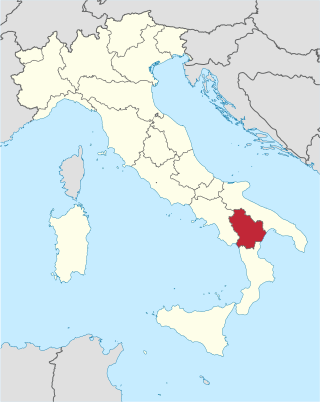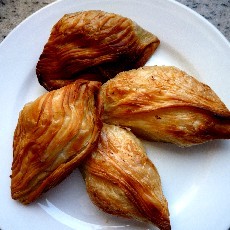
Basilicata, also known by its ancient name Lucania, is an administrative region in Southern Italy, bordering on Campania to the west, Apulia to the north and east, and Calabria to the south. It has two coastlines: a 30-km stretch on the Tyrrhenian Sea between Campania and Calabria, and a longer coastline along the Gulf of Taranto between Calabria and Apulia. The region can be thought of as the "instep" of the "boot" of Italy, with Calabria functioning as the "toe" and Apulia the "heel".

Calzone is an Italian oven-baked turnover, made with leavened dough. It originated in Naples in the 18th century. A typical calzone is made from salted bread dough, baked in an oven and stuffed with salami, ham or vegetables, mozzarella, ricotta and Parmesan or pecorino cheese, as well as an egg. Different regional variations in or on a calzone can often include other ingredients that are normally associated with pizza toppings. The term usually applies to an oven-baked turnover rather than a fried pastry, though calzoni and panzerotti are often mistaken for each other.

Bresaola is air-dried, salted beef that has been aged two or three months until it becomes hard and turns a dark red, almost purple colour. It is made from top (inside) round, and it is lean and tender, with a sweet, musty smell. It originated in Valtellina, a valley in the Alps of northern Italy's Lombardy region.

Peasant foods are dishes eaten by peasants, made from accessible and inexpensive ingredients.

A turnover is a type of pastry made by placing a filling on a piece of dough, folding the dough over, sealing it, and then baking it. Turnovers can be sweet or savoury and are often made as a sort of portable meal or dessert. They are often eaten for breakfast.

Confit is any type of food that is cooked slowly over a long period as a method of preservation.

Italian-American cuisine is a style of Italian cuisine adapted throughout the United States. Italian-American food has been shaped throughout history by various waves of immigrants and their descendants, called Italian Americans.

A pastizz is a traditional savoury pastry from Malta. Pastizzi usually have a filling either of ricotta or curried peas. Pastizzi are a popular and well-known traditional Maltese food. It should not be confused with the Italian pastizz, better known as u' pastizz 'rtunnar.

Rotondella is a town and comune in the province of Matera, in the Southern Italian region of Basilicata.

Panzerotto, also known as panzarotto, is a savory turnover, that originated in central and southern Italian cuisine, which resembles a small calzone, both in shape and dough used for its preparation. The term usually applies to a fried turnover rather than an oven-baked pastry, though calzoni and panzerotti are often mistaken for each other.

Arrosticini are a class of traditional dishes of skewered grilled meat characteristic of Molisana and Abruzzese cuisine. Arrosticini are typically made from mutton or lamb cut in chunks and pierced by a skewer. It is cooked on a brazier with a typically elongated shape, called furnacella, which resembles a gutter.

Venetian cuisine, from the city of Venice, Italy, or more widely from the region of Veneto, has a centuries-long history and differs significantly from other cuisines of northern Italy, and of neighbouring Austria and of Slavic countries, despite sharing some commonalities.

Sgabeo is a food typical of Lunigiana, an Italian historical region now divided between Liguria and Tuscany. This is leavened bread dough, cut into strips, fried and salted on the surface that is traditionally eaten plain or stuffed with cheese or cold cuts. Lately, however, it is not uncommon that the sgabeo is also proposed as a sweet, filled with pastry cream or chocolate.

The traditional cuisine of Abruzzo is eclectic, drawing on pastoral, mountain, and coastal cuisine. Staples of Abruzzo cuisine include bread, pasta, meat, fish, cheese, and wine. The isolation which has characterized the region for centuries has ensured the independence of its culinary tradition from those of nearby regions. Local cuisine was widely appreciated in a 2013 survey among foreign tourists.

Apulian cuisine consists of the cooking traditions and practices of the region of Apulia in Italy. Starting from the Middle Ages the permanent residence of the nobility in the region gradually declined, which caused the disappearance of their noble cuisine over time. As the common people suffered from poverty, their culinary tradition adapted to use cheap and simple foods. Bread, vegetables and pasta have the leading role in the cuisine. Fruits, fish and wine are consumed frequently as well, but meat plays a minor role. The food of Apulia is known as a prime example of cucina povera or 'cuisine of the poor', characterizing its simplicity rather than its quality. Moreover, the simple dishes allow the quality of their local and seasonal ingredients to take center stage.

The peperone crusco, also known as crusco pepper, is a typical product of the Basilicata region of Italy.

The cuisine of Basilicata, or Lucanian cuisine, is the cuisine of the Basilicata region of Italy. It is mainly based on the use of pork and sheep meat, legumes, cereals and vegetables, with the addition of aromas such as hot peppers, powdered raw peppers and horseradish. The local gastronomy is, for historical-cultural reasons, typically peasant, based on simple recipes and on the culture of reuse, in particular of meat and bread.















